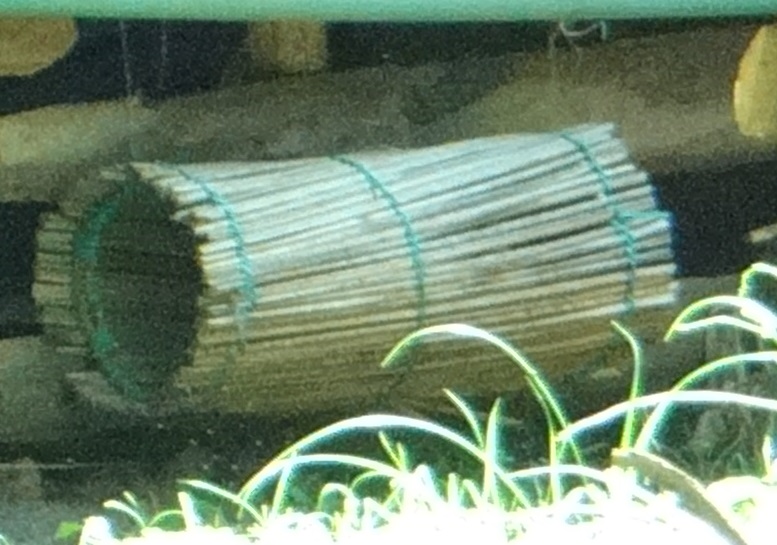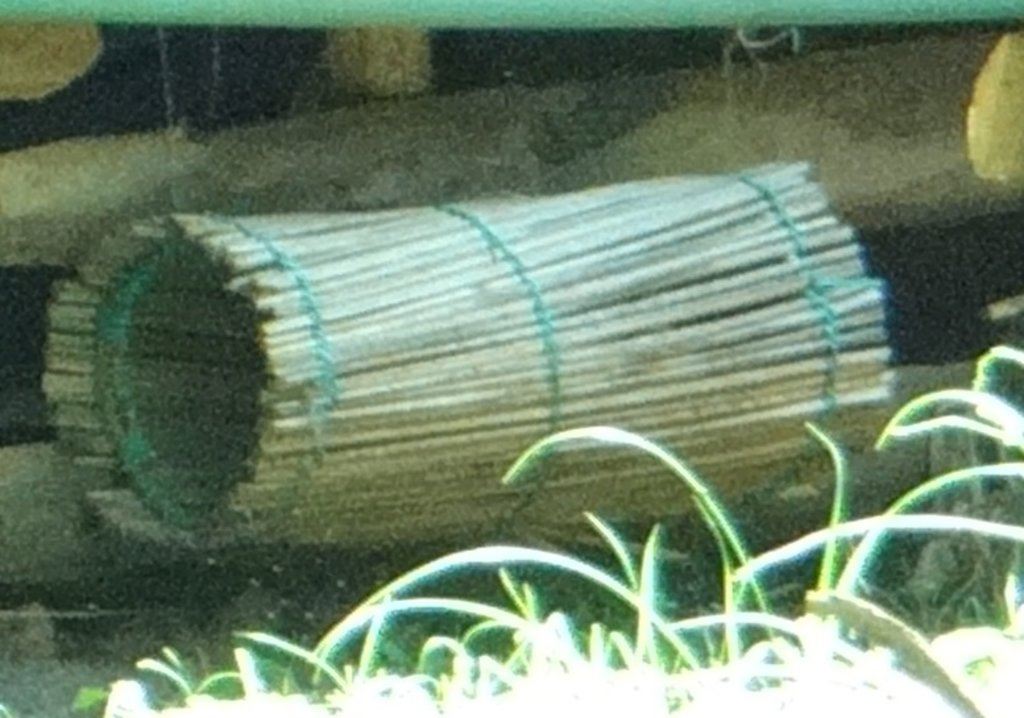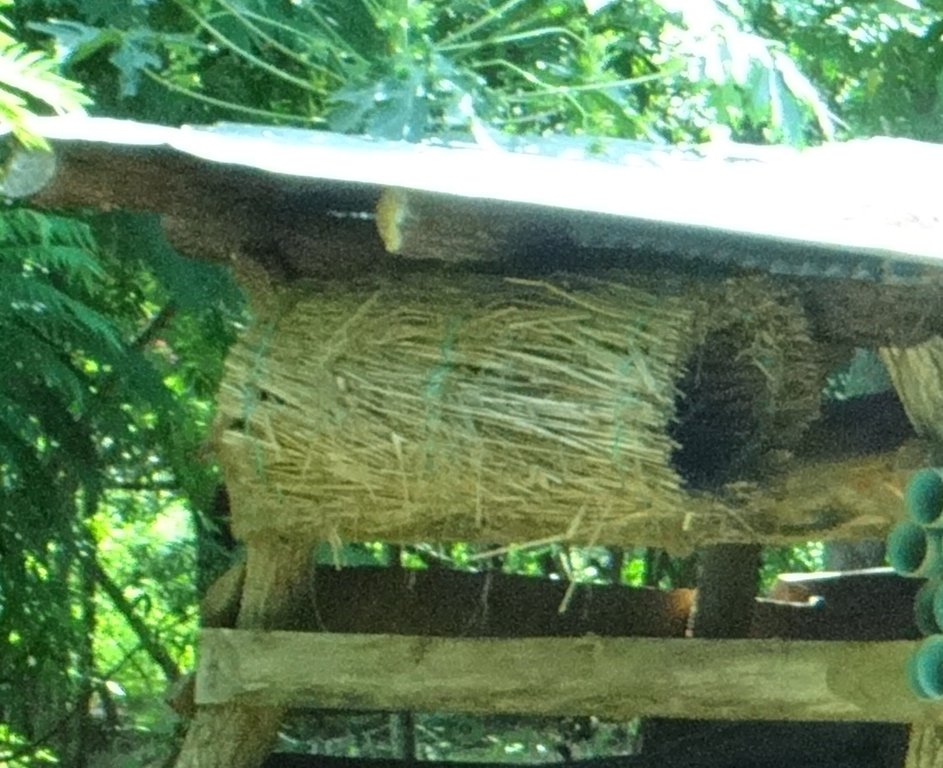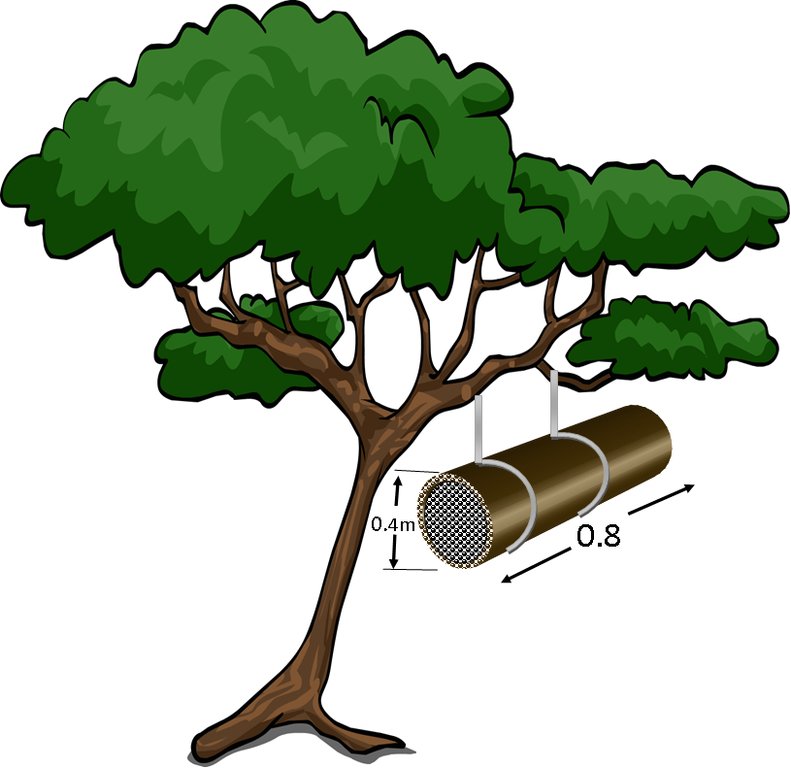Bamboo-Woven Bee Hives [Uganda]
- Creation:
- Update:
- Compiler: Bernard Fungo
- Editors: JOY TUKAHIRWA, betty adoch, Kamugisha Rick Nelson, Sunday Balla Amale
- Reviewer: Udo Höggel
Pito kic Ki Bong koo onyo Yen ma iye twolo
technologies_2838 - Uganda
View sections
Expand all Collapse all1. General information
1.2 Contact details of resource persons and institutions involved in the assessment and documentation of the Technology
Key resource person(s)
land user:
Okello Samuel
Farmer
Padibe west, Lamwo District
Uganda
Name of project which facilitated the documentation/ evaluation of the Technology (if relevant)
Scaling-up SLM practices by smallholder farmers (IFAD)Name of the institution(s) which facilitated the documentation/ evaluation of the Technology (if relevant)
Bern University of Applied Sciences, School of Agricultural, Forest and Food Sciences (HAFL) - Switzerland1.3 Conditions regarding the use of data documented through WOCAT
When were the data compiled (in the field)?
12/5/2017
The compiler and key resource person(s) accept the conditions regarding the use of data documented through WOCAT:
Ja
1.4 Declaration on sustainability of the described Technology
Is the Technology described here problematic with regard to land degradation, so that it cannot be declared a sustainable land management technology?
Nee
2. Description of the SLM Technology
2.1 Short description of the Technology
Definition of the Technology:
Using relatively cheap and locally available bamboo material to make bee hives is adaptable to local setting and reduces harvesting of large native trees
2.2 Detailed description of the Technology
Description:
In northern Uganda, traditional bee hives used to be made from large tree trunks chiseled into a hollow cylindrical piece of tree trunk. Owing to increased demand for more hives and due to extensive destruction of suitable trees, farmers now use locally available bamboo stems for making bee hives. This technology, apart from being a response to decreasing availability of materials such as large tree trunks that were previously used to make bee hives, it is also meant to provide a cheaper alternative to expensive modern bee hives such as the top-bar and Langstroth.
Bamboo canes are peeled into sheets of approximately 2-3 meters, and weaved in a manner similar to the way the baskets are made but in a cylindrical shape. The hives are constructed with a length varying from 0.5-0.8 m, and 0.4 m in diameter. The resulting open-ended cylinder is then covered with a grass layer of about 2 cm thick and wrapped with polythene strings to keep the grass in place. The grass is meant to insulate the hive against heat. The open ends of the cylinder are closed using a wooded circular piece of wood punched with about 10 holes of 1 cm diameter. It is through these holes that bees enter the hive. The completed hives are hung into a tree, where the bees colonize and produce honey. The hive should face north or south to protect it from the direction of sun and rain. The sun heat melts the honey comb from which honey is extracted.
The apiary should be free from termites, birds, and hygiene should be fully maintained. The hives may also be hung on two poles attached by wires that are used to hang them. These poles should be greased to avoid being damaged by termites, bush fire and red ants. The apiary should be 30 m away from the main road, flowering plants and also near water source within 100 m is recommended.
An apiary with bamboo-woven been hives conserves the natural environment and honey extracted from the honey comb generates income to the farmer. Shades must be provided at the apiary site during dry seasons. To protect the apiary, scouting should be frequently done. Bees are harmful and the apiary occupies land from other activities like agriculture.
Farmers like this type of hive because it produces relatively clean honey compared to other systems. Furthermore, the bamboo hives last relatively longer because they are affected less by degrading insects. The low cost compared to other hives such as the top-bar or langstroth make it preferred by the bee farmers. However, there is also a high risk of fire since the hive is fitted with grass that could catch fire.
2.3 Photos of the Technology
2.4 Videos of the Technology
Date:
10/05/2017
Location:
Padibe, West Lamwo Distict
2.5 Country/ region/ locations where the Technology has been applied and which are covered by this assessment
Country:
Uganda
Region/ State/ Province:
Northern
Further specification of location:
Ayom Village, Abakadyak Parish
Map
×2.6 Date of implementation
Indicate year of implementation:
2009
2.7 Introduction of the Technology
Specify how the Technology was introduced:
- through land users' innovation
3. Classification of the SLM Technology
3.1 Main purpose(s) of the Technology
- reduce, prevent, restore land degradation
- conserve ecosystem
- preserve/ improve biodiversity
- create beneficial economic impact
3.2 Current land use type(s) where the Technology is applied

Forest/ woodlands
(Semi-)natural forests/ woodlands:
- Selective felling
Products and services:
- Timber
- Fuelwood
- Fruits and nuts
- Grazing/ browsing
- Nature conservation/ protection
3.3 Further information about land use
Water supply for the land on which the Technology is applied:
- rainfed
Comments:
The technology uses limited rainwater, since the bees can move long distances looking for water
Number of growing seasons per year:
- 2
Specify:
In most cases during any dry spell which can take more than three weeks
3.4 SLM group to which the Technology belongs
- natural and semi-natural forest management
- windbreak/ shelterbelt
- beekeeping, aquaculture, poultry, rabbit farming, silkworm farming, etc.
3.5 Spread of the Technology
Specify the spread of the Technology:
- applied at specific points/ concentrated on a small area
Comments:
Spreading of the technology depends on the presence of trees
3.6 SLM measures comprising the Technology

structural measures
- S9: Shelters for plants and animals
- S11: Others

management measures
- M3: Layout according to natural and human environment
- M5: Control/ change of species composition
Comments:
This is an integrated approach on the natural trees
3.7 Main types of land degradation addressed by the Technology

soil erosion by water
- Wt: loss of topsoil/ surface erosion

soil erosion by wind
- Et: loss of topsoil

physical soil deterioration
- Pu: loss of bio-productive function due to other activities

biological degradation
- Bc: reduction of vegetation cover
- Bs: quality and species composition/ diversity decline
3.8 Prevention, reduction, or restoration of land degradation
Specify the goal of the Technology with regard to land degradation:
- prevent land degradation
4. Technical specifications, implementation activities, inputs, and costs
4.1 Technical drawing of the Technology
4.2 Technical specifications/ explanations of technical drawing
Length of hive: 0.8m
Diameter: 0.4m
4.3 General information regarding the calculation of inputs and costs
Specify how costs and inputs were calculated:
- per Technology unit
Specify unit:
One peace
other/ national currency (specify):
Uganda shilling
Indicate exchange rate from USD to local currency (if relevant): 1 USD =:
3500.0
Indicate average wage cost of hired labour per day:
5000
4.4 Establishment activities
| Activity | Type of measure | Timing | |
|---|---|---|---|
| 1. | Cutting bamboo | Other measures | Any time but mostly during the dry season |
| 2. | Pealing | Other measures | Any time but mostly during the dry season |
| 3. | Weaving bee hives | Other measures | Any time but mostly during the dry season |
4.5 Costs and inputs needed for establishment
If possible, break down the costs of establishment according to the following table, specifying inputs and costs per input. If you are unable to break down the costs, give an estimation of the total costs of establishing the Technology:
5000.0
| Specify input | Unit | Quantity | Costs per Unit | Total costs per input | % of costs borne by land users | |
|---|---|---|---|---|---|---|
| Labour | Harvesting bamboo canes | Manhours | 3.0 | 5000.0 | 15000.0 | 100.0 |
| Labour | Pealing the bamboo canes | Manhours | 5.0 | 5000.0 | 25000.0 | 100.0 |
| Labour | Weaving the been hives | Manhours | 15.0 | 5000.0 | 75000.0 | 100.0 |
| Equipment | Bamboo canes | Pieces | 30.0 | 1500.0 | 45000.0 | 100.0 |
| Equipment | Strings | Rolls | 1.0 | 6000.0 | 6000.0 | 100.0 |
| Equipment | Baits | Piece | 1.0 | 10000.0 | 10000.0 | 100.0 |
| Total costs for establishment of the Technology | 176000.0 | |||||
Comments:
Protection from fire is done by the land user since it is in the farm
4.6 Maintenance/ recurrent activities
| Activity | Type of measure | Timing/ frequency | |
|---|---|---|---|
| 1. | Slashing around the beehives | Management | During the dry season |
Comments:
Most maintenance activities were done during the dry season
4.7 Costs and inputs needed for maintenance/ recurrent activities (per year)
If possible, break down the costs of maintenance according to the following table, specifying inputs and costs per input. If you are unable to break down the costs, give an estimation of the total costs of maintaining the Technology:
1.0
| Specify input | Unit | Quantity | Costs per Unit | Total costs per input | % of costs borne by land users | |
|---|---|---|---|---|---|---|
| Labour | Slashing | Area (acres) | 1.0 | 30000.0 | 30000.0 | 100.0 |
| Total costs for maintenance of the Technology | 30000.0 | |||||
Comments:
The technology is almost self sustaining
4.8 Most important factors affecting the costs
Describe the most determinate factors affecting the costs:
Routine visits during the dry season
5. Natural and human environment
5.1 Climate
Annual rainfall
- < 250 mm
- 251-500 mm
- 501-750 mm
- 751-1,000 mm
- 1,001-1,500 mm
- 1,501-2,000 mm
- 2,001-3,000 mm
- 3,001-4,000 mm
- > 4,000 mm
Agro-climatic zone
- sub-humid
5.2 Topography
Slopes on average:
- flat (0-2%)
- gentle (3-5%)
- moderate (6-10%)
- rolling (11-15%)
- hilly (16-30%)
- steep (31-60%)
- very steep (>60%)
Landforms:
- plateau/plains
- ridges
- mountain slopes
- hill slopes
- footslopes
- valley floors
Altitudinal zone:
- 0-100 m a.s.l.
- 101-500 m a.s.l.
- 501-1,000 m a.s.l.
- 1,001-1,500 m a.s.l.
- 1,501-2,000 m a.s.l.
- 2,001-2,500 m a.s.l.
- 2,501-3,000 m a.s.l.
- 3,001-4,000 m a.s.l.
- > 4,000 m a.s.l.
Indicate if the Technology is specifically applied in:
- not relevant
5.3 Soils
Soil depth on average:
- very shallow (0-20 cm)
- shallow (21-50 cm)
- moderately deep (51-80 cm)
- deep (81-120 cm)
- very deep (> 120 cm)
Soil texture (topsoil):
- medium (loamy, silty)
Soil texture (> 20 cm below surface):
- medium (loamy, silty)
Topsoil organic matter:
- medium (1-3%)
If available, attach full soil description or specify the available information, e.g. soil type, soil PH/ acidity, Cation Exchange Capacity, nitrogen, salinity etc.
The soil is not a basic requirement for the technology
5.4 Water availability and quality
Ground water table:
5-50 m
Availability of surface water:
good
Water quality (untreated):
good drinking water
Is water salinity a problem?
Nee
Is flooding of the area occurring?
Nee
Comments and further specifications on water quality and quantity:
Water is also used for drinking, especially from protected sites
5.5 Biodiversity
Species diversity:
- medium
Habitat diversity:
- medium
Comments and further specifications on biodiversity:
It is a mixed crop farm with protected water source
5.6 Characteristics of land users applying the Technology
Sedentary or nomadic:
- Sedentary
Market orientation of production system:
- mixed (subsistence/ commercial
Off-farm income:
- 10-50% of all income
Relative level of wealth:
- average
Individuals or groups:
- individual/ household
Level of mechanization:
- animal traction
Gender:
- men
Age of land users:
- middle-aged
Indicate other relevant characteristics of the land users:
The land user is educated
5.7 Average area of land owned or leased by land users applying the Technology
- < 0.5 ha
- 0.5-1 ha
- 1-2 ha
- 2-5 ha
- 5-15 ha
- 15-50 ha
- 50-100 ha
- 100-500 ha
- 500-1,000 ha
- 1,000-10,000 ha
- > 10,000 ha
Is this considered small-, medium- or large-scale (referring to local context)?
- medium-scale
5.8 Land ownership, land use rights, and water use rights
Land ownership:
- individual, not titled
Land use rights:
- individual
Water use rights:
- individual
5.9 Access to services and infrastructure
health:
- poor
- moderate
- good
education:
- poor
- moderate
- good
technical assistance:
- poor
- moderate
- good
employment (e.g. off-farm):
- poor
- moderate
- good
markets:
- poor
- moderate
- good
energy:
- poor
- moderate
- good
roads and transport:
- poor
- moderate
- good
drinking water and sanitation:
- poor
- moderate
- good
financial services:
- poor
- moderate
- good
6. Impacts and concluding statements
6.1 On-site impacts the Technology has shown
Socio-economic impacts
Production
crop production
Comments/ specify:
Improve pollination of crop flowers leads to improved yields
crop quality
Comments/ specify:
Presence of bees in farm also deters other harmful insects that destroy crops or transmit crop pests and diseases
animal production
Comments/ specify:
As a livestock, it results into more honey produced
risk of production failure
Comments/ specify:
Bees easily colonize hives made of locally available bambo or stake materials within their environment
land management
Comments/ specify:
This approach ensures integrated land management
Income and costs
expenses on agricultural inputs
Comments/ specify:
Cost of buying a hive is not incurred
farm income
Comments/ specify:
High yield of honey gives more income to the farmer
diversity of income sources
Comments/ specify:
Both from crops, animals and honey.
workload
Comments/ specify:
Easy to manage the bees since there is little need to put baits
Socio-cultural impacts
food security/ self-sufficiency
Comments/ specify:
Farmers harvest adequate honey which is also rich in nutrients
health situation
Comments/ specify:
Honey contain high nutrient content and also acts as antibiotics against some infections
community institutions
Comments/ specify:
Through marketing of the bee products in farmer groups
SLM/ land degradation knowledge
Comments/ specify:
Farmers learn how to utilize locally available materials to make hives. e.g bamboo, ropes
conflict mitigation
Comments/ specify:
In areas near national parks, bee keeping reduces human wildlife conflicts because bees repel away wild animals from reaching the farm stead
Ecological impacts
Biodiversity: vegetation, animals
plant diversity
Comments/ specify:
Pollination by bees improves plant diversity
invasive alien species
Comments/ specify:
Bees repel away some invasive insects from the environment
beneficial species
Comments/ specify:
Increase in bees as social insects
habitat diversity
Comments/ specify:
The habitat become more diverse and plant species increase
pest/ disease control
Comments/ specify:
Bees repel away some pests which infest crops or spread crop diseases
Climate and disaster risk reduction
micro-climate
Comments/ specify:
Increase in plant diversity because of the presence of bees create a bio-diverse micro climate
6.3 Exposure and sensitivity of the Technology to gradual climate change and climate-related extremes/ disasters (as perceived by land users)
Gradual climate change
Gradual climate change
| Season | Type of climatic change/ extreme | How does the Technology cope with it? | |
|---|---|---|---|
| seasonal temperature | dry season | increase | moderately |
Climate-related extremes (disasters)
Biological disasters
| How does the Technology cope with it? | |
|---|---|
| epidemic diseases | not well |
6.4 Cost-benefit analysis
How do the benefits compare with the establishment costs (from land users’ perspective)?
Short-term returns:
positive
Long-term returns:
very positive
How do the benefits compare with the maintenance/ recurrent costs (from land users' perspective)?
Short-term returns:
positive
Long-term returns:
very positive
Comments:
The benefits increase with time due the number of products and the colonization of the hives
6.5 Adoption of the Technology
- 1-10%
Of all those who have adopted the Technology, how many have did so spontaneously, i.e. without receiving any material incentives/ payments?
- 90-100%
Comments:
This technology is traditional and farmers who keep bees learn them from others within the community
6.6 Adaptation
Has the Technology been modified recently to adapt to changing conditions?
Nee
6.7 Strengths/ advantages/ opportunities of the Technology
| Strengths/ advantages/ opportunities in the land user’s view |
|---|
| Easy to manage |
| No additional cost after establishment |
| Strengths/ advantages/ opportunities in the compiler’s or other key resource person’s view |
|---|
| It is highly sustainable |
6.8 Weaknesses/ disadvantages/ risks of the Technology and ways of overcoming them
| Weaknesses/ disadvantages/ risks in the land user’s view | How can they be overcome? |
|---|---|
| Fire | Early clearing |
| Its a medium term investment | Constant replacement |
| Weaknesses/ disadvantages/ risks in the compiler’s or other key resource person’s view | How can they be overcome? |
|---|---|
| Sometimes the hives may not be colonized | Continuously checking |
7. References and links
7.1 Methods/ sources of information
- field visits, field surveys
2
- interviews with land users
1
Links and modules
Expand all Collapse allLinks
No links
Modules
No modules






